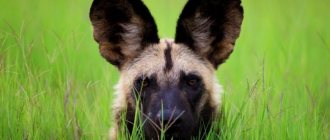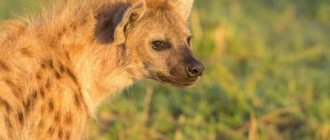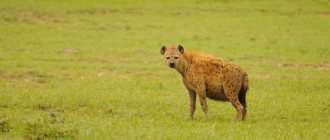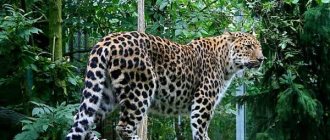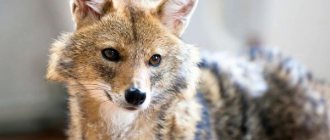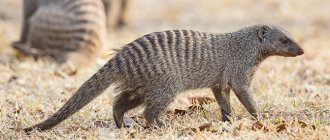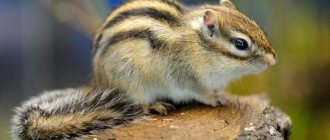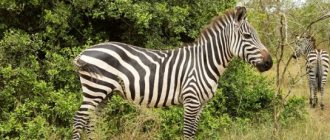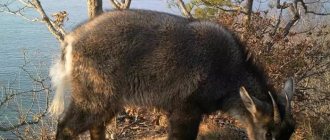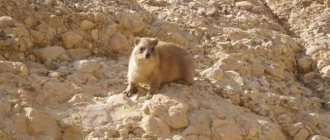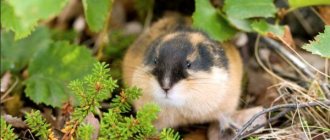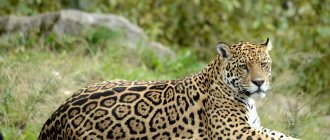Description and features
She looks really unattractive. The body is long, the neck is powerful, motionless, the muzzle is unattractive. The front legs are longer than the hind legs and are crooked, so it looks like it's hunched over. She has 4 toes on her paws. The head is large, the ears are carelessly cut off by nature and practically without hair.
The eyes are set askew, besides, they constantly run around and are very shiny. That's why their expression is scary. The tail is of medium size, rather fluffy, the hair is not smooth, ragged, long, with stubble on the back. The color is dark, gloomy. The entire body is covered with irregularly shaped spots or stripes. All this creates a rather repulsive image for the animal.
The hyena in the photo is not a very aesthetic sight. On the one hand, like any animal, it is interesting to look at. On the other hand, looking at her does not bring pleasure. Her voice is really unpleasant.
Sometimes she makes short barking sounds, then it looks like she is laughing. And this makes it even more creepy. “Hell's laughter,” people say when they hear the hyena laugh. There is an expression “laughs like a hyena.” Usually this is said about a person who laughs evilly at his interlocutor. And you shouldn’t expect anything good from him.
Listen to the sounds of a hyena:
This animal is greedy, eats a lot and untidy, walks with an ugly limp. The teeth are remarkably developed: they are located straight, in one line, so it has a wide, flattened muzzle. The forehead is small, extremely strong cheekbones, powerful muscles of mastication, large salivary glands, and a tongue with warts. This is the appearance of our heroine.
Let's add to this that the hyena is a nocturnal animal. And now imagine that you met this beast, or a flock of such animals somewhere in the desert. It is clear why they frightened the local residents so much. Moreover, it is this predator that they say that she chooses the weak and defenseless, the sick and wounded, and attacks them.
That's why the man didn't love her. He set traps, poisoned, destroyed. However, if this predator was caught as a puppy, it quickly tamed and became a pet, almost like a dog.
These mythical animals
Rarely do any animals cause such hostility in people as hyenas - neither their appearance nor their wild behavior during the hunt inspires positive emotions in anyone. For a long time they were considered one of the most mysterious and little-studied creatures of this world, and therefore the most incredible rumors circulated about them, which, oddly enough, even the most prudent people believed.
For example, the indigenous people of Africa, looking at the persistence and enthusiasm with which these animals tore up graves, were convinced that hyenas were associated with evil spirits, and that they themselves were werewolves. When the Arabs killed this animal, they buried its head as deep as possible in the sand so that it would not return and take revenge for its murder.
Koalas are the original representatives of the living world of Australia174214.811
The ancient Greek philosopher Ovid believed (and substantiated his opinion so convincingly that he was able to convince many reasonable people) that an animal is a hermaphrodite and is capable of changing its gender. And his colleague Pliny argued that the spotted hyena, imitating the sound of a human voice, lures adults and children into the street, where it tears them apart.
Experiencing such mystical horror towards this wild animal, many agreed that medicines made from the internal organs of these creatures had miraculous powers: the liver healed the eyes, the cervical vertebra calmed the nervous system. But the brain was considered harmful: those who ate it went crazy.
What wonderful animals
Hyenas are members of a family of predatory mammals from the suborder Felidae. Interesting fact: if previously these animals were considered relatives of dogs, recently scientists came to the conclusion that such a classification was incorrect and added them to the family of cats and civets.
The hyena family includes species such as the aardwolf, striped, spotted and brown hyena. All these species live on the African continent, and the striped hyena also lives in Asia (they mainly live in steppes, semi-deserts and savannas, and the brown one can be seen near the coast).
What do they eat?
Striped, brown hyenas are scavengers. But when there are problems with carrion production, they can feed on bird eggs, open nests, and catch small vertebrates and invertebrates.
Spotted hyenas hunt small animals; in packs they can drive large animals. If possible, they can take prey from leopards, cheetahs, and jackals. In situations where there are farms and private houses in the territory where predators are distributed, they can steal pets. Speaking of hungry times, spotted hyenas feed on food waste and carrion.
These predators have a very unpretentious, strong digestive system. She can even process bones. However, in addition to the flesh of killed prey and carrion, hyenas eat watermelons and melons if they can find them.
What is the name of a baby elephant?
It's called
, how else?
Although in the cartoon about Mowgli, the elephants
have the generic name Hathi, and even the little elephant who fell into the hole, who is rescued in the first film,
is called
the wise Hathi.
Interesting materials:
What kind of gasoline is better to fill in Sorento? What kind of gasoline should I fill in the Kia Sportage? What kind of gasoline should I put in Creta? What kind of gasoline should I use in cold weather? What kind of gasoline should I put in Renault Logan 2? What kind of gasoline should I put in my snow blower? What budget is considered balanced? Which budget hammer drill is better? What kind of business can be opened in the park? What kind of business can you open for $3,000?
Behavior of hyenas in a pack
Most hyena species live in clans (20-100 individuals). In the wild, males usually predominate over females, but this is not all about hyenas. They have absolute matriarchy.
The hierarchy is built in an unusual way:
- The eldest female hyena is the most privileged. It is she who eats the prey first and takes a break from the African heat in the best place in the hole. The main female determines the role of each clan member in the pack.
- Privileged females are among the first to eat after the main female and occupy VIP places in the hole.
- Females of a lower class. They rest a little away from the privileged females and start dinner after them.
- Males. This is the lowest class. They are the last to be allowed to eat.
The status of female hyenas can be easily determined by the position of their tail. The higher he is, the higher position she occupies in the clan.
The female queen carefully ensures that the borders of the territory are guarded by a “patrol”. Their task is to notify the flock of the approach of “strangers”. In addition, those on duty mark the boundaries with their “fragrant” secretions. The disgusting smell notifies other predators that the territory is under protection.
Suborder Caniformes (or Canidae)
According to the classification, there are not as many canine-like animals as there are cat-like animals. The cutest of them are raccoons: fluffy and very thick fur, a long and shaggy tail. The species, however, are very few. But there are much more canines (or canines). This includes arctic foxes, foxes, dogs (there are wild raccoons, hyenas, dingoes), coyotes, jackals and, of course, wolves. These are very interesting animals. Most often, dogs are larger than average in size, they have well-defined erect ears, and an elongated head. The front paws have five toes, and the hind paws have four; they cannot retract their claws. Dogs' fur is also very rich - thick and fluffy, winter is not scary for them. Where do animals of the canine suborder live? They did not settle only in Antarctica; they live in large numbers on other continents. Some species of animals gather together and hunt in packs, while others are accustomed to acting alone and independently.
iv>
Surprisingly, bears - both white and brown, and all their other species - also belong to the canine suborder. These are serious and dangerous animals: massive, very large, with powerful paws, deadly claws and unpredictable behavior. There is also a representative of the panda family in the squad, very similar to a bear. This is a small panda that previously inhabited all of Eurasia and even Africa and America. Now this cute animal is rare, it is on the verge of extinction. There are pandas left in zoos and a little in the forest in southeast Asia. Representatives of the mustelid family are also becoming fewer and fewer every year, especially those who have precious thick fur. Everything disappears - sable, ermine, marten, polecat, weasel, sea otter, otter, badger. There are enough species of animals in this family, but representatives of these species are not so easy to find even in the taiga.
Members of the skunk family look nothing like either a dog or a bear. They are small in stature, but, nevertheless, very, very dangerous animals. In America, people are probably more afraid of meeting a skunk than a bear. The fact is that these animals have glands from which, when danger appears, an extremely corrosive and disgusting-smelling substance is released. And the animal itself is a very cute and interesting animal: a fluffy tail, white spots or stripes on thick and long black fur. But the skunk is equipped like a real predator: the physique is strong, the claws are amazingly sharp, and the teeth are not bad at all.
In the order of Canidae, according to the classification of animals, not only land animals are listed. There are also sea creatures that seem not at all like dogs. These are eared seals that sometimes weigh more than a thousand kilograms and have a corresponding body length - up to three and a half meters. Their females, however, are a little smaller. The family of eared seals includes sea lions and fur seals (and these seals are in the suborder Canidae, yes). Among the marine dog-like inhabitants there are two more groups of interesting animals - the walrus family and the family of true seals. Among walruses there is one representative - the walrus. And there are a lot of seals: leopard seals, elephant seals, lionfish, seals.
Source: zoogalaktika.ru
Lifestyle and habitat
The most free and comfortable conditions in which the hyena lives are the savannas of Africa. They live in open desert grassy areas called the savanna belt. They stay close to the edges of small forests, next to bushes and single trees.
The year in such places is divided into 2 seasons - summer and autumn. The climate here is either very dry or very rainy. There is no average. The African world is full of predators worse than our heroine. Therefore, they are often forced to flock together in order to protect their prey.
A pack of hyenas is always close to food, they are voracious and insatiable. They accompany a large and hearty lunch with their famous laughter, but this attracts lions. They already know that at this moment the hyenas have prey. So it turns out that she needs to eat everything as quickly as possible. Hence the greed in food.
It is not for nothing that the confrontation between the hyena and the lion is often mentioned. These two animals usually live close to each other, share the same food territory and compete with each other. Moreover, victory occurs alternately for both sides.
Contrary to popular belief, it is not hyenas who take prey from lions, but vice versa. The luckier, faster and more determined hyenas are more likely to make a profit. Several lionesses are able to cope with them and take the victim. The signal for an attack is the cry of a hyena.
They try to mark their territory with odorous substances to scare away unwanted raiders, but this does not always help. Sometimes they change their location and go to another place. Usually due to lack of food. Hyena is a nocturnal animal. Hunts at night, rests during the day.
This animal is hardy, despite its external awkwardness. It develops high speed when running away from an enemy or hunting. The speed of a hyena can reach 65-70 km/hour. Moreover, she calmly runs long distances.
They have glands on their paws that emit odor. Each hyena has its own. This is how they get to know each other. In a pack of hyenas, there is usually a hierarchy, like all animals. However, each of them is trying to take a place at the tastiest piece.
Nutrition
They say that in Africa there are no skeletons lying around - everything is eaten by hyenas, whose stomachs can hold about fifteen kilograms of food at a time. All representatives of this family, with the exception of the aardwolf, are omnivorous creatures: they are unpretentious in food and eat absolutely everything they can - mammals, birds, snakes, termites, fish, melon, watermelon. They have rightfully earned a reputation as scavengers, capable of completely gnawing a corpse.
It was recently discovered that, in addition to everything else, they are also excellent hunters, and they eat carrion for lack of better food. Apart from the brown hyena, which is the largest land creature, its diet consists mainly of carrion, and the striped hyena, like the jackal, likes to pick up garbage.
The aardwolf feeds mainly on termites of a certain species, Trinervitermes, sometimes on other insects and their larvae, which it collects on animal corpses (primarily carrion beetles), as well as arachnids. During the night, it is quite capable of eating up to 300 thousand termites, while the animal does not destroy termite mounds, but patiently waits for the insects to come to the surface.
Thanks to these insects, this representative of the hyena family is almost independent of water, since it receives liquid from their bodies. In addition to Trinervitermes, the aardwolf also feeds on other types of animal food - usually small rodents, birds and their eggs, and sometimes plants.
But the spotted hyena is considered one of the most formidable predators in Africa, since representatives of this species combine enormous speed (more than 50 km/h), powerful jaws, skillful collective actions (they usually hunt in pairs or even in a pack) and amazing audacity.
Interesting facts about raccoons174214.714
The spotted hyena eats its victims in a unique way, as do other representatives of this family. From the outside it looks extremely disgusting and nauseating, since before a meal they do not kill their victims, but despite their screams, they eat them alive (although this way the prey dies faster than by strangulation).
Features and Specifications
As for the characteristics of these predators, it is necessary to consider their hunting methods, protective status, and relationships in the pack.
The hierarchy between individuals of the same flock is based on several principles:
- Older females take the leading role. They receive the most privileges - they are the first to try the prey, relax in cool places, and not in the sun. At the same time, they give the largest and healthiest offspring compared to the others.
- Low-class females are inferior to their elders in privileges. They begin to eat only after the elders have finished their meal. They are allowed to rest away from older females.
All other members of the pack follow the low-class females in the hierarchical chain.
In terms of hunting, hyenas gather in packs to drive down prey. In this case, predators can pursue the selected prey over a distance of 5 km, accelerating up to 65 km/h. Due to this, most animals cannot escape from the pack.
Every year the population of all types of hyenas is declining. This is due to a reduction in the natural food supply, environmental pollution, and human development of new territories. At the same time, these predators are poorly studied due to the fact that they live in hard-to-reach areas and are predominantly nocturnal.
In order to protect the hyena population from complete extinction, as well as to better study these animals, their habits, behavioral characteristics, and communications, separate spacious enclosures are being built in zoos all over the world to house them.
Characteristics of predators
There is even a single formula to describe the teeth of land carnivores, they are so similar. According to the list of animals, predators have the same number of incisors, canines, small and primary molars (premolars and molars). The two molars are enlarged in size, their sharp edges are capable of crushing bones and tendons, and cutting into flesh like a knife into soft butter. The cheekbones and jaws are very powerful, the temporal muscles also work when capturing prey; no description of the animals can convey the strength of this bite.
When running, predators rely either on their toes or on their entire foot. There are almost always sharp claws at the tips of four or five fingers; many are able to retract them. The vast majority of predators are covered with fur, all have a tail, often a long one. Their internal structure is also very similar: they all have a stomach, a short intestine, a large brain with grooves on the cortex, which shows their intelligence (it’s the same in humans - the more convolutions on the cerebral cortex, the smarter the person).
Animals of the surrounding world have even surpassed humans in many ways: they hear better, some see much better, distinguish thousands of times more odors and smell them many kilometers away. Predators have a huge number of reflexes and instincts, which allows them not to waste time thinking: a tiger, for example, immediately hides or jumps on its prey, which very often saves its life or brings success in the hunt. It is because of the presence of such magnificent instincts that animals are dangerous; they attack without hesitation. A person usually takes a long time to decide on this or that action, he considers the situation, weighs the chances. And this is correct in most cases. But if an unexpected situation suddenly arises, you need to act quickly, like a predator does. For example, if a natural disaster is a flood, earthquake, or fire or something similar. Here you need to obey your instinct and speed of reaction is your salvation.
Reproduction is also characteristic of all predatory animals. All female carnivores give birth to live young and feed them with milk from glands located on the abdomen. They usually have offspring once a year, with the exception of small predators that reproduce more often, but their babies are much less adapted to the world around them, they are blind, helpless and need parental attention for a long time. All animals treat their offspring responsibly, even those that do not live in families. A mother will never let her child be harmed.
Interesting facts about hyenas
- In ancient Egypt, hyenas were bred for meat.
- Predators greet their relatives like dogs.
- Their cubs are born with their eyes open and from the age of one year they hunt with their mother.
- Hyenas are superior in intelligence to even chimpanzees and make decisions instantly.
- Females have higher levels of the male hormone (testosterone) compared to males. Perhaps for this reason matriarchy reigns in the clan.
- The hyena's stomach is capable of digesting even skin and bones.
- The animal is a real terror of the savannas. Powerful jaws allow them to cling to their prey with a death grip. Predators never kill their prey, but eat it alive as they move.
- Hyenas are not cowards, as many people believe. They are capable of taking prey even from a lion. And old weak lions can become their victims themselves.
- There are tribes in Africa who believe that hyenas are messengers of the Sun. They revere these predators more than the leader.
Appearance
Average parameters of brown hyenas:
- Body length – 120 cm;
- Height – 80 cm;
- Tail length – 30 cm;
- The weight of males is 42 kg;
- The weight of females is 40 kg.
The coat is very long and shaggy. The color is dark brown, the paws and head are gray. There are black spots and stripes on the legs. Through a small, muzzle is extended. The ears are long and pointed.
The brown hyena has an additional anal gland that secretes a white or black secretion. It is needed to mark the territories where predators live, warn and scare away enemies.
